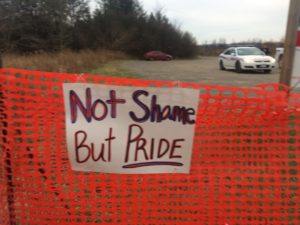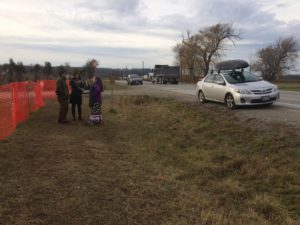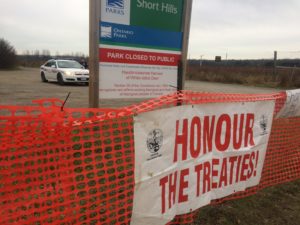The right to live without harassment- Short Hills 2017

by Manchari Paranthahan, SCM Brock
Every year, a 6-day deer harvest at the Short Hills Provincial Park honours Haudenosaunee Treaty and Land rights. The Haudenosaunee people have exercised their legal right to hunt, but several members of local animal rights groups have actively protested against the hunt in violent ways, from barricading entrances to the park to carrying signs with white supremacist and racist messages on them to oppose the hunt. These anti-hunt protesters have been able to organize a vehicle stall with the Ontario Provincial Police and the Niagara Regional Police Department to create an additional obstacle to the access to the park. Unfortunately, the anti-hunt protesters continuously seem to find new ways to ignorantly perform microaggressions against a vulnerable community in the Niagara region. Since 2013 the Short Hills has hosted the Haudenosaunee Right to Hunt Reconciliation events and activities in response.
The first Short Hills activity I attended this year was the ‘Sweet Blood’ documentary screening held at Brock University. This documentary focused on the high number of Cree community members who suffer from diabetes as a result of a colonized diet. The documentary emphasizes the importance of Indigenous people needing to eat and gather food in traditional ways not only to upkeep tradition but also for their health. During this screening I was told by one of the organizers of the hunt that the documentary left out testimonies from a few Cree men who had mentioned that returning to their old ways of hunting and eating actually cured them of their diabetes. They were left out because of funding through a government grant that didn’t want these testimonies in the final product, to prevent controversies with pharmaceutical companies creating medical treatments for people who have diabetes. “It’s like another form of colonization,” said the organizer, describing both the ways that a colonial diet has affected the health of Cree people and how they were being policed through what information made the final cut of the documentary.
Trailer of SWEET BLOOD – The Cree Living Well With Diabetes from Whirlygig Productions on Vimeo.
The Niagara Anti-Racism Coalition also did a workshop for supporters of the hunt on challenging white supremacy in the Niagara Region. The workshop involved having members of the community share their stories and experiences with white supremacy in the region. These stories were then printed out and brought to the harvest. The supporters at the harvest were asked to read out one of the experiences or share their own and then take a rock from a bowl that was placed next to the fire. This was to represent how every time an act of greed or fear caused by white supremacy impacts any one of us, we take away from the bettering of society and the love we have to give to each other. This simple act emphasized how we are all affected negatively by oppression and silencing.
After we all went around the circle, we were asked to then share a way that we can help change and challenge white supremacist actions and then put the rock we took back in the bowl. This was to represent the ways we can all contribute to a better society and community. This workshop was a powerful one as I got to see how different members of the same community that identified in different ways were able to put aside the things that made us different and instead focus on how we can all help each other. It was a creative way of acknowledging the responsibility we have in creating a better society whether we are the oppressor or the oppressed – a crucial point to acknowledge in contemporary social justice politics. This workshop allowed space for everyone and allowed them to say what they believed to be true in regards to the Short Hills hunt as well as white supremacy in general, making for a safe and brave space.

This was my second year at the counter protest and I have seen firsthand the dedication and hard work that goes into organizing the reconciliation activities. The organizers and supporters of the hunt do everything possible to get as many voices heard and represented during the reconciliation activities. This year, a representative from the Brock Students for Animal Liberation was able to talk about white privilege, animal rights and how that affects their stance on the issue and why they still support the hunt. The two-fold understanding of the issue, something that strips a community of their traditional practice and is also responded to with violently racist language, is something that seems to be happening more and more within the community.
Throughout all of this I found the workshop done by the Christian Peacemaker Teams about de-escalation tactics to be extremely helpful in dealing with the complexities. I was able to go to three of the harvest days and witnessed the multiple ways the protesters would oppose the hunt. Through barricading the entrances, to drowning out the music of the drummers, to overpowering the supporters with their shouts and by flashing lights and taking pictures of the hunters, it is clear how much of this issue has stemmed from systemic racism. The freedom with which the anti-hunt protesters can express violent messages, create an environment with additional obstacles and stay firm in their problematic beliefs can only be a result of socially ingrained racism against Indigenous communities.
During the workshop on de-escalation, we talked about how humour and distraction can be key strategies to prevent derailing. As a student activist, this information was useful because of the way student activism gets criticized for being inaccessible because of the elite nature of institutions. In my experience, more often than not student activism gets met with ignorance or intentional derailing tactics. Learning the different ways that we can acknowledge our own triggers and then use humour and distraction as a way of combating negative behaviour emphasized the importance of doing this work in institutions as well as doing on-the-ground frontline activism work – there will always be resistance no matter how it’s done, but it will always be worth it.

Throughout this conversation we also ended up talking a lot about intersectionality; the ways our different identities intersect with one another and how they affect experiences of privilege and oppression. It is important to see how this issue is intersectional , as the Haudenosaunee community ends up dealing with a lot of racist oppression as well as oppression through their cultural practices, something that the animal rights activists on the other side of the Short Hills entrance seem to glaze over. The intersectional nature of the protests, the “animal rights vs. treaty rights” conversation, also creates a tense atmosphere. Intersectionality is a tricky thing, one that can pit activists against each other.
In contemporary society, when we talk feminism we have to acknowledge the micropolitics that have often been overlooked throughout history. When we fail to recognize the communities that we have missed so far in mainstream feminism movements, we are contributing to harmful structures that white supremacists have put in place. As Audre Lorde puts it, “There is no such thing as a single-issue struggle because we do not live single-issue lives.” Intersectionality here, and in most social issues is something that is often discussed but rarely put into practice when it comes to our activism – why is that?
The Short Hills accompaniments have always stressed the importance of education, love and acceptance in our teachings. Everyday at the harvest I found myself asking why anti-hunt animal rights activists were pushing so hard to keep the Haudenasaunee hunters out of the park when some of the hunt’s supporters are vegan animal rights activists themselves. Wasn’t the damage that has been done to Indigenous peoples throughout history already clear? Doesn’t it make sense to take a minute to hear the other side? Why are microaggressions still being overlooked and not viewed as just as harmful and damaging as blatantly forms of racism? These questions still remain and have provided a realization that these issues aren’t getting worse or resurfacing – it is just our turn dealing with them.
The closing ceremony for the Short Hills Reconciliation Events and Activities was celebrated with a lovely feast on the last harvest day, a panel discussion and another screening of ‘Sweet Blood’. The past five years has seen growing support for the counter protestors and the Haudenosaunee people. There have been more collaborations with local groups for workshops and activities available for the supporters at the reconciliation events. The growing support for the hunters over the years has created more room for conversations, change and acceptance. Moving forward, through educating and being open to reconciliation, hopefully the Haudenosaunee Right to Hunt continues to get more support than resistance.
Manchari Paranthahan is a Communications, Women and Gender Studies and Theatre student at Brock University. They are involved in various activist movements at the University and in the Niagara Region, including the Brock SCM and the Brock Student Justice Centre. As the current Program Director of the Brock Faith and Life Centre, Manchari and SCM Coordinator Emilie Philips are dedicated to bringing social justice work and activism into their faith work.
